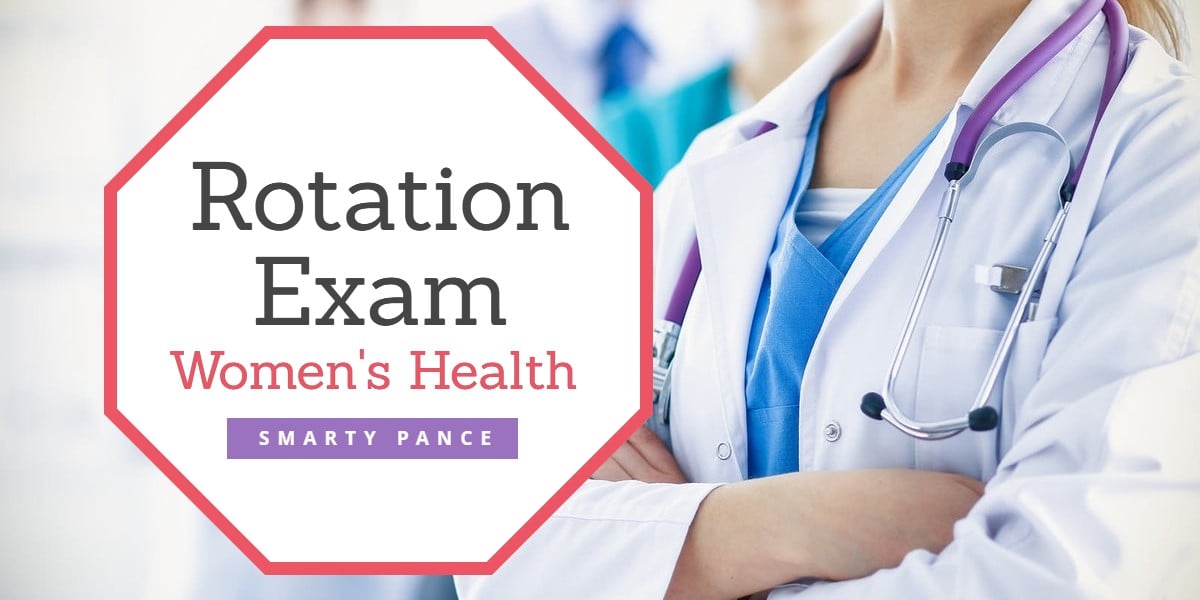
Women's Health and Reproductive System / OB GYN Clinical Rotation Exam
Introducing two new Interactive Women's Health and Reproductive System/Obstetrics Rotation Exams now available to PA students and all members of Smarty PANCE. Not yet a member? You can Join Now and Save.
These exams follow the format of the PAEA Women's Health End of Rotation Exam™ Blueprint and are perfect as preparation for your after rotation exams and the boards. Smarty PANCE is not sponsored or endorsed by, or affiliated with, the Physician Assistant Education Association. All trademarks are the property of their respective owners.
The Smarty PANCE Rotation Exam for Women's Health follows the PAEA published EOR content blueprint:
Gynecology
- Menstruation (15%)
- INfections (12%)
- Neoplasms (10%)
- Disorders of the breast (8%)
- Structural abnormalities (5%)
- Other (5%))
Obstetrics
- Prenatal care/normal pregnancy (16%)
- Pregnancy complications (15%)
- Labor and delivery complications (8%)
- Postpartum care (6%)
Here is a five-question sample from the Smarty PANCE women's health rotation exam (members only).
Women's Health and OB GYN Rotation Sample Exam
Question 1 |
- fasting: 90 mg/dl
- 1-hour: 195 mg/dl
- 2-hour: 145 mg/dl
- 3-hour: 130 mg/dl
No gestational diabetes | |
Class A1 gestational diabetes | |
Class A2 gestational diabetes | |
Class B gestational diabetes |
Question 2 |
Carbon dioxide laser Hint: Carbon dioxide laser is expensive and requires good training and the use of local or general anesthesia. | |
Cryotherapy Hint: Cryotherapy can be done in the office without the use of anesthesia; however, it can disrupt future colposcopic exams because of the inability to see the squamocolumnar junction. | |
Colposcopy Hint: See E for explanation | |
Electrosurgical excision procedure (LEEP) Hint: See E for explanation | |
C or D |
Question 3 |
Increased FSH, increased LH, increased androstenedione Hint: Menopause is characterized by increased FSH and LH, with roughly stable androstenedione levels. | |
Increased FSH, increased LH, no change in androstenedione | |
Decreased FSH, decreased LH, increased androstenedione Hint: Menopause is characterized by increased FSH and LH, with roughly stable androstenedione levels. | |
Decreased FSH, no change in LH, no change in androstenedione Hint: Menopause is characterized by increased FSH and LH, with roughly stable androstenedione levels. | |
No change in FSH, decreased LH, increased androstenedione Hint: Menopause is characterized by increased FSH and LH, with roughly stable androstenedione levels. |
Question 4 |
Chlamydia Hint: The treatment for chlamydia is azithromycin or doxycycline. | |
Candidiasis Hint: Candidiasis would be treated with an imidazole. | |
Trichomoniasis | |
Staphylococcus Hint: Staphylococcus infection could be treated by many different antibiotics other than metronidazole. |
Question 5 |
10-12 weeks Hint: See B for explanation | |
15-18 weeks | |
20-22 weeks Hint: See B for explanation | |
24-28 weeks Hint: See B for explanation |
|
List |
More Smarty PANCE Rotation Exams
We're excited to add these two women's health and OB GYN/Reproductive system rotation exams to a growing list of clinical rotation exams available exclusively to Smarty PANCE members.
- General Surgery Clinical Rotation Exam and QBank
- Emergency Medicine Clinical Rotation Exams
- Pediatrics Clinical Rotation Exam and QBank
- Emergency Medicine Rotation Exam Two
- Women’s Health PANCE Exam
- Family Practice Rotation Exam
Other exams include 13 Topic Specific Practice Exams, two full-length PANCE/PANRE Mock Practice Exams, five 250 Question Comprehensive Exams, and many, many more!
The best way to prep for your boards and rotation exams is with practice questions and highly focused review. Smarty PANCE combines both by linking blueprint topics to exam questions giving you the best of both worlds.
Don't waste time studying topics outside your required scope. It is our hope to provide you with the most streamlined and focused rotation exam and PANCE/PANRE board review available at the best price.
Warmly,
Stephen Pasquini PA-C
Physician Assistant and SmartyPANCE founder




